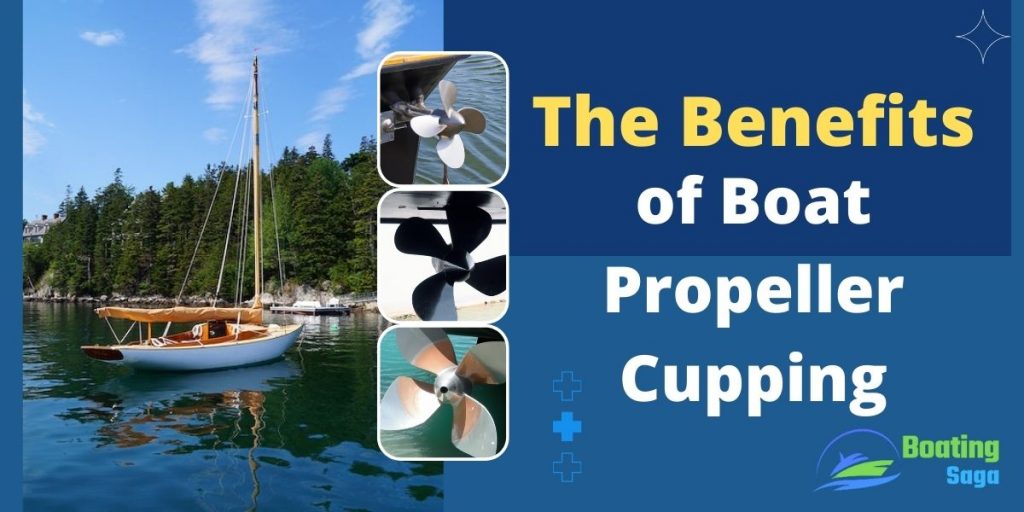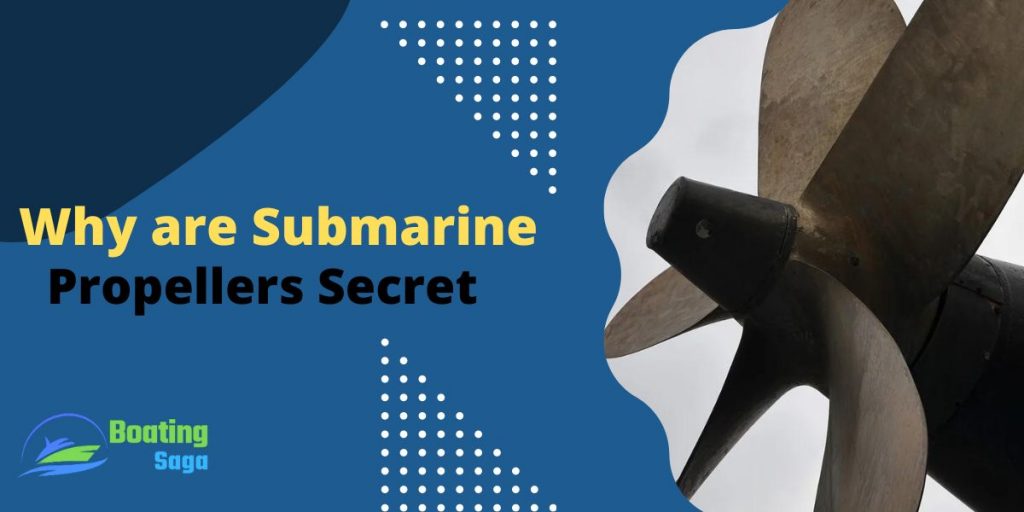
Boat propellers are designed with cupping in order to increase their efficiency. Cupping is the process of adding a small lip or curve to the edge of the propeller blade. This lip helps to create a mini vortex at the trailing edge of the blade which in turn provides a small boost to thrust.
So, What does cupping a boat propeller do?
When a boat is cupped, the propeller blades are slightly bent inward. This gives the propeller more bite and prevents it from slipping. The result is increased speed of the boat, better fuel efficiency, and reduced wear and tear on the engine. Cupping also helps to reduce vibration and noise from the engine.
While the amount of thrust generated by this mini vortex is relatively small, it can make a noticeable difference in the performance of your boat. In addition, cupping also helps to protect your propeller from damage. The lip on the blade acts as a shock absorber, absorbing impact and helping to prevent nicks and scrapes.
The Science Behind Prop Cupping: How Does It Work?
There is a science behind the practice of prop cupping, and it can be explained by looking at how boats work. When a boat is moving forward by help of the propeller, it creates a water current that flows around it. This current pushes against the back of the boat, propelling it forward. The blades of the propeller are angled so that they create this water current.
The cupped shape of a propeller blade helps to increase the amount of thrust created by the propeller. The curved leading edge of the blade causes the water to flow more quickly over the blade, which increases the pressure on the back of the blade and creates more thrust.
The cupped shape also helps to reduce cavitation, which is when bubbles form in the water around the propeller and cause it to lose power.
How to Tell if Your Propeller is Cupped?

If you’re not sure whether or not your boat propeller is cupped, there are a few things you can look for.
- First, take a look at the leading edge of the blade. If it’s rounded or notched, that’s a sign that the blade is cupped.
- Next, look at the trailing edge of the blade. If it’s thinner than the rest of the blade, that’s another sign that it’s cupped.
- Finally, hold the propeller up to a light source. If you can see light shining through the blades, that means they’re no longer parallel and are probably cupped.
If you suspect your propeller is cupped, the best way to tell for sure is to take it to a qualified marine technician and they will be able to tell you for sure
The Benefits of Boat Propeller Cupping

Boat props that have been cupped offer many advantages to boat owners.
1. Increase Thrust - Cupped propellers create less drag and increases thrust which allow the engine to run more efficiently. In addition, cupping can increase the thrust of the propeller by as much as 15 percent.
2. Reduce Cavitation - Cupped propellers also tend to be more durable than their non-cupped counterparts and are less likely to suffer from cavitation. Cavitation is caused by bubbles forming on the blades of the propeller and can cause serious damage. By reducing cavitation, cupping also helps to extend the life of your boat prop.
3. Reduce Turbulence & Stress - Propeller cupping can also help to protect your boat and engine. By reducing the amount of turbulence created by the propeller, you’ll also reduce the amount of stress on your engine. This can lead to a longer lifespan for your engine, as well as reduced wear and tear on other components of your boat.
4. Increased Fuel Efficiency - Cupped propellers can also help to improve fuel efficiency. Since they are able to generate more thrust with less power, they will not require as much fuel to operate. This can save money over time, as well as help to reduce pollution from boat engines.
5. Reduce Vibration and Noise - Boat prop cupping is an effective way to reduce vibration and noise. By cupping the props, it helps to create a more efficient and smoother running engine. This in turn reduces vibration and noise.
Overall, cupping is an effective way to improve the performance of your boat prop. It’s important to note, however, that not all props need to be cupped.
The Drawbacks of Prop Cupping
Most boat operators are aware of the potential benefits of cupping their propellers, by adding curve to the blades. However, there are also some drawbacks to this practice that should be considered before deciding to cup your own propellers.
Cupped propellers can wear down more quickly than regular ones. The increased friction created by the curved blades puts more stress on the metal, which can cause them to degrade faster. This means you’ll have to replace your propellers more often if you choose to cup them.
A cupped propeller can also cause damage to the boat’s hull if it’s not properly alligned or angled!
Boat Prop Cupping: Good or Bad?

There are a few schools of thought when it comes to boat prop cupping.
Some believe that it is beneficial because it increases the surface area of the propeller that is in contact with the water. This can create more thrust and potentially make the boat go faster. Others believe that cupping might cause turbulence and reduce fuel efficiency.
So, what is the verdict? Is boat prop cupping good or bad? Unfortunately, there is no clear answer. It really depends on the boat and the propeller in question. Some boats perform better with cupped propellers while others do not. The only way to know for sure is to experiment with different types of propellers and see what works best for your particular vessel.
How to Add Cup to a Prop: Easy Step-by-Step Process
Cup a boat propeller by following these steps:
1. Secure the boat to a dock or another object so it doesn’t move.
2. Lift the propeller out of the water using a rope or similar device.
3. Inspect the propeller for damage. If there are any broken or bent in the blades, have them repaired or replaced before proceeding.
4. Use a cup-shaped tool to gently bend the tips of the blades inward. This will create more lift and reduce drag when the propeller is in use.
5. Reinstall the propeller and test it out to see if it performs better than before.
Cupping a prop is not difficult, but it’s important to be careful and take your time. Be sure to use the right cupping tool, and follow all manufacturer instructions carefully. With just a little bit of effort, you can greatly improve your boat’s performance by cupping its propeller blades!
Tips for Boat Prop Cupping Intact

There are a few things that you can do in order to get the most out from your boat prop.
1. Make sure that you regularly inspect your propeller for any damage. If you see any wear and tear, it is important to have it repaired or replaced as soon as possible.
2. Try avoid running your boat in shallow water. This can cause the propeller to strike objects which can damage the cupping. If you must run in shallow water, be sure to go slowly and avoid any sudden turns or stops.
3. Make sure your propeller is the correct size and pitch for cupping of your boat.
4. Make sure that your boat propeller is installed correctly. If you are unsure, consult a professional.
5. Cupping should be done every few months or as needed, depending on usage.
6. Always check with your manufacturer or dealer for specific cupping instructions for your model of boat propeller.
7. Keep your prop clean and free of debris. This will help it last longer and perform better.
Follow these tips and you’ll be sure to keep your boat prop in good cupping condition for years to come!
Cupped Vs Uncupped Boat Prop

There are two main types of boat propellers - cupped and uncupped. Each has its own advantages and disadvantages that need to be considered when choosing the right one for your vessel.
Cupped propellers are designed to provide more thrust than their uncupped counterparts. This makes them ideal for larger boats that need to move through the water quickly. However, they are also more susceptible to damage and can be difficult to repair if they become damaged.
Uncupped propellers, on the other hand, offer less thrust but are much more durable. They are a good choice for smaller boats as well as propeller that don’t need as much power to move through the water. They are also easier to repair if they become damaged since there is no cup to worry about replacing.
Frequently Asked Questions:
Is Cupping a Boat Propeller Really Worth It?
Cupping is when the edges of the propeller blades are bent slightly inward.
Yes, cupping a boat propeller can be worth it, especially if you use your boat for watersports where you need maximum performance from your engine. Slightly inward blades give the propeller more bite and helps it grip the water better. It also increases the amount of thrust generated by the propeller.
Of course, there are very few downsides to cupping a propeller.
What is the Best Metal for Boat Prop Cupping?
There are many factors to consider when choosing the best metal for boat prop cupping.
Aluminum is the most popular metal for boat prop cupping. It is lightweight and has a very low co-efficient of friction. Aluminum is also very corrosion resistant. Stainless steel is another popular metal for boat prop cupping.
It is heavier than aluminum, but it has a higher co-efficient of friction. Stainless steel is also more corrosion resistant than aluminum.
Brass and bronze are not as popular as aluminum or stainless steel for boat prop cupping, but they can be used. Brass has a lower co-efficient of friction than aluminum or stainless steel.
Where I Can Find Propeller Cupping Tools?
There are a few places you can find propeller cupping tools.
Your local hardware store is a good place to start. You can also find them online, at websites like Amazon or eBay. Finally, you can check with your boat mechanic or dealer to see if they have any recommendations for where to find the best cupping tools.
If you’re not sure what you’re looking for, ask a salesperson for help. They should be able to point you in the right direction. Once you have your tool, follow the instructions on the package to properly cup your propeller.
Conclusion
I hope you get your answer that, What Does Cupping a Boat Propeller Do?
Cupping a boat propeller can improve the performance of the boat by increasing the speed and efficiency of the propeller. It can also help to reduce fuel consumption and noise levels.
If you are considering cupping your boat propeller, be sure to do some research and talk to a qualified professional to ensure that it is the right decision for you and your boat!
You can also read:


